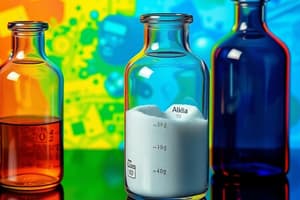Podcast
Questions and Answers
What is one of the main advantages of using glass as packaging material?
What is one of the main advantages of using glass as packaging material?
- It is biodegradable and environmentally friendly.
- It can be produced quickly and cheaply.
- It is lightweight and easily disposable.
- It is chemically inert and does not react with contents. (correct)
Which property of glass allows visibility of the contents within?
Which property of glass allows visibility of the contents within?
- Chemically inert
- Transparent (correct)
- Non-permeable
- Mouldable
Which of the following describes the non-permeable nature of glass?
Which of the following describes the non-permeable nature of glass?
- It prevents gases, odors, vapors, and liquids from penetrating. (correct)
- It allows gases and liquids to pass through.
- It can absorb moisture from the environment.
- It requires a special coating to block contaminants.
Which of these materials is NOT a raw material used to make glass?
Which of these materials is NOT a raw material used to make glass?
What characteristic of glass allows it to be shaped into various containers?
What characteristic of glass allows it to be shaped into various containers?
What is the primary function of chromium, cobalt, and iron in glass manufacturing?
What is the primary function of chromium, cobalt, and iron in glass manufacturing?
Which type of glass is primarily used for injectables and transfusions?
Which type of glass is primarily used for injectables and transfusions?
At what temperature does the glass melting furnace typically operate during melting?
At what temperature does the glass melting furnace typically operate during melting?
What is the main advantage of the unlimited supply of materials for glass production?
What is the main advantage of the unlimited supply of materials for glass production?
Which step in the glass manufacturing process serves to eliminate bubbles from the molten glass?
Which step in the glass manufacturing process serves to eliminate bubbles from the molten glass?
Flashcards
Chemically Inert
Chemically Inert
Glass doesn't react with what it holds, keeping the contents pure and fresh.
Non-Permeable
Non-Permeable
Nothing can get in or out of glass containers - gases, smells, liquids, etc.
Transparent
Transparent
Glass is see-through, allowing you to view the contents inside.
Mouldable
Mouldable
Signup and view all the flashcards
Type I Glass (Borosilicate)
Type I Glass (Borosilicate)
Signup and view all the flashcards
Type II Glass (Neutral)
Type II Glass (Neutral)
Signup and view all the flashcards
Type III Glass (Soda-Lime)
Type III Glass (Soda-Lime)
Signup and view all the flashcards
Refining
Refining
Signup and view all the flashcards
Molding
Molding
Signup and view all the flashcards




